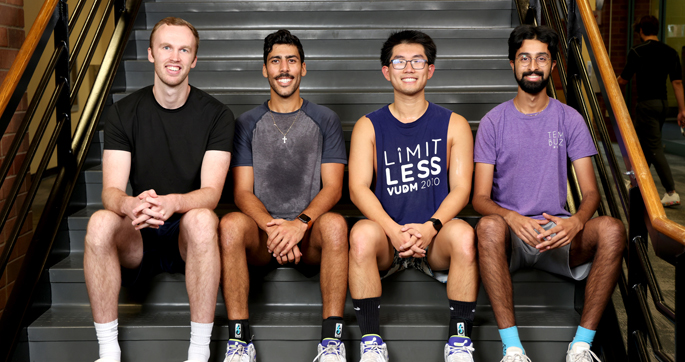
As his second year of medical school was coming to a close — with just one final exam left to take the next day — Daniel Ragheb and a few Vanderbilt University School of Medicine classmates headed to the on-campus recreation center to play a game of five-on-five basketball.
It was something the friends did nearly every day, either at the rec center or outside at a nearby park. On Thursday, June 23, the gym was a fortuitous choice. About 50 minutes into play, Ragheb had possession of the ball and then collapsed to the floor, landing on his right side.
“In the first few seconds I thought he was messing with us, but then I realized he was not responding to me, and he began to have seizure-like movements in his arms,” said VUSM classmate and roommate, Brian Hou. “I noticed his eyes were wide open, so I knelt down next to him and began pressing on his chest to start CPR.”
Ragheb, 24, was experiencing sudden cardiac arrest. His classmate Shreyas Krishnapura called for someone to get the AED in the gym while he and classmate Joel Johnson helped Hou administer CPR. First-year student Yash Pershad continuously checked for a pulse, which was very faint.
“The staff at the rec center did a great job of getting the AED as quickly as possible and helping us coordinate CPR with the AED shocks,” said Pershad.
Ragheb, lying on the court, was unable to respond to commands.
“It was haunting to see. We proceeded to rotate doing CPR on Danny for a total of seven to eight minutes, in between three shocks from the AED. A minute or so after the third shock, Danny was able to push me off of him mid-CPR, letting us know he was back,” Johnson said.
The medical students had received Basic Life Saving training, but none had performed it on a person.
“This was also my first time performing CPR on a real person, let alone on a friend. I remember an initial feeling of terror at what was happening followed by a resolve to calmly act and help. When performing compressions, I focused hard on staying present and not letting my thoughts wander to what could happen if we failed. Our only priority was to concentrate on Danny’s well-being,” said Krishnapura.
Ragheb was conscious when he arrived at the VUMC Emergency Department, where he underwent multiple cardiac tests to determine why his heart suddenly stopped working.
Although he had heart surgery at Stanford at age 14 to repair a leaky bicuspid aortic valve, he had not had any serious complications since. It was that experience that put him on the path to medical school, he said.
“That was when I first decided I wanted to go to medical school,” said Ragheb, who has completely healed from his recent near-death experience. “That’s what made me want to do cardiac surgery too.”
At Vanderbilt, many of his mentors, teachers and colleagues provided care to him.
“I was very lucky to have this happen at Vanderbilt,” Ragheb said.
After reviewing the AED report, his physicians determined he experienced an episode of ventricular tachycardia — an abnormal heart rhythm — although it is unclear why.
As a precaution, Ragheb received an implantable cardioverter defibrillator (ICD) in his chest to detect and stop irregular heartbeats. He is back to playing basketball and well into his third year of medical school, still intent — perhaps more so — on becoming a cardiac surgeon.
“I’ve felt 100% fine since then with no real issues,” he said. “There have been countless blessings around the whole thing. Brian, Joel and I are very close friends. I’ve always appreciated them, even more so now. I sometimes go alone to a gym. You could imagine the outcome would be different if other medical students weren’t there, including those who knew I had a medical issue and were able to think quickly on their feet.
“On top of that, we sometimes play outdoors at a park that does not have an AED. I’m very grateful for these friends and classmates before this, but especially after, for how quick they were able to think,” Ragheb said.
There are more than 356,000 out-of-hospital cardiac arrests annually in the U.S., nearly 90% of them fatal. If performed immediately, CPR and AEDs can double the chance of survival from an out-of-hospital cardiac arrest, according to the American Heart Association.












